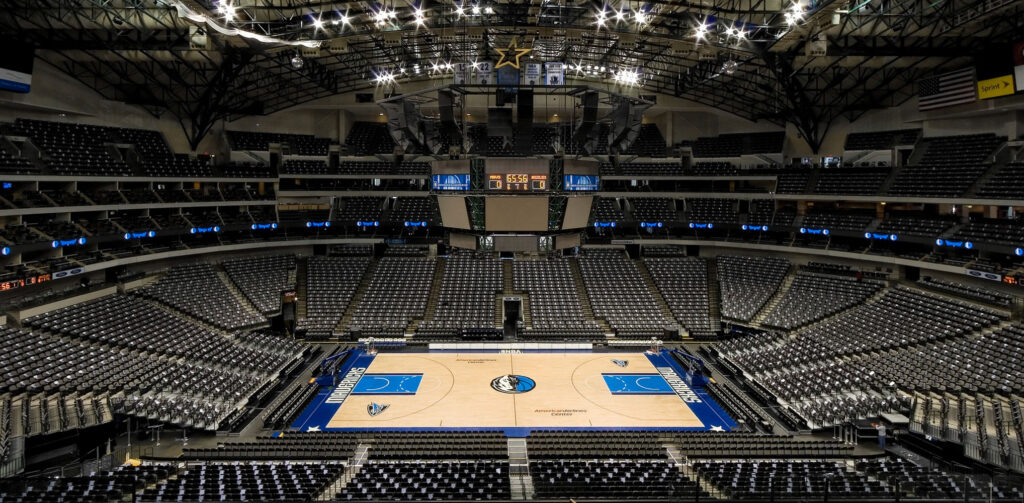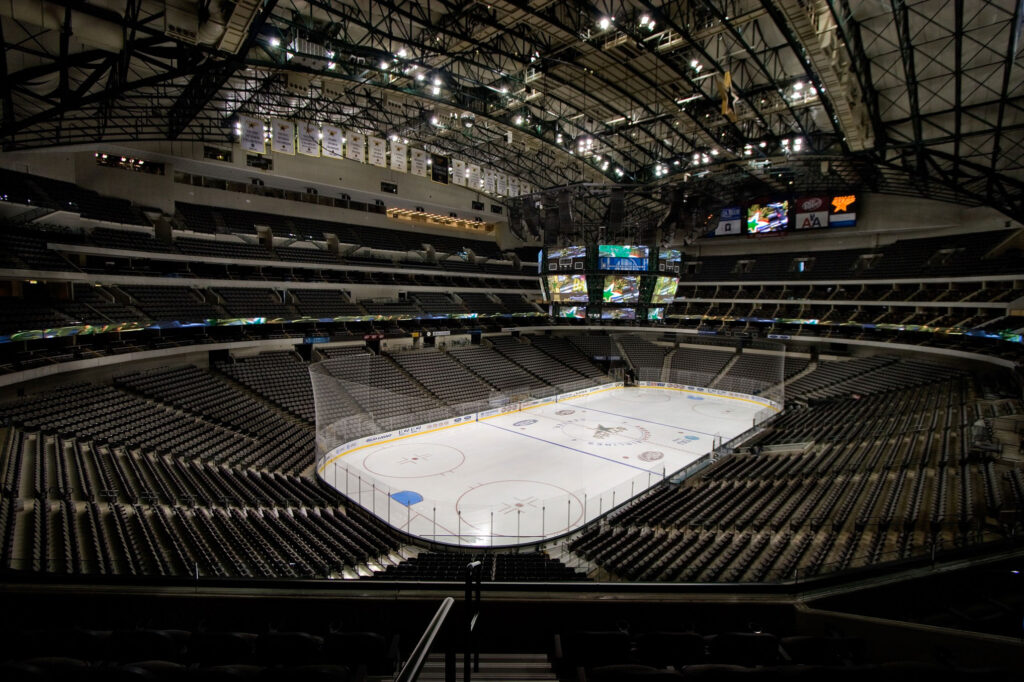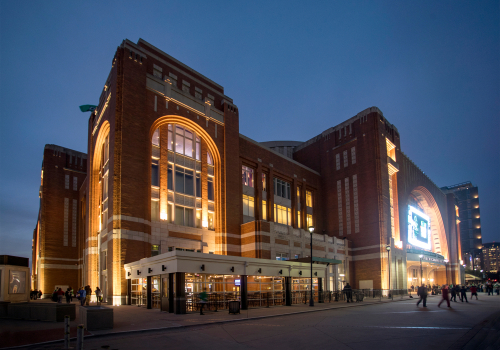In Part 2 of our NBA Finals Stadium Series, learn all about the American Airlines Center (AAC) in Dallas, Texas! The stadium is home to the Dallas Mavericks, who will play the Boston Celtics for the 2024 National Basketball Association (NBA) Finals. The championship games will be split between the two teams’ home-court venues from June 6 and up to June 23 in a best-of-seven series.

Games 1 and 2 (and games 5 and 7, if necessary) will be played at the Celtics home court at TD Garden in Boston, Massachusetts, on June 6 and 9 (and 17 and 23, if necessary), as the team is the No. 1 overall seed, giving them the home-court advantage. TD Garden was highlighted in Part 1 of Facilities Management Advisor’s NBA Finals Stadium Series.
In contrast, games 3 and 4 (and game 6, if necessary) will be played at the Mavericks’ home court on June 12 and 14 (and June 20, if necessary) at AAC.
Notably, Facilities Management Advisor previously profiled AAC in 2023, when the venue hosted the NCAA Women’s Final Four, but Part 2 of this series provides an update on last year’s article.
Whether you watch the NBA Finals from a stadium seat or see all the action from the comfort of your home, you’ll likely be cheering on your favorite basketball team to be crowned 2024 basketball champion.
While the players on the floor are where the action is, facilities professionals worldwide will be focused on another one of the show’s stars: AAC.
What You Need to Know
- Name: American Airlines Center
- Location: Dallas, Texas
- Owner: Center Operating Company (COC)
- Cost: $420 million
- Seating capacity: 18,532 for ice hockey; 20,000 for basketball; and up to 21,000 for concerts. Additionally, there are premium seating options.
- Size (total area): 840,000 square feet (sq ft)
- Size (playing surface): 17,000 sq ft with dasher boards inserted and 19,125 sq ft with south-end seats retracted and corresponding dasher boards removed
- Concourse levels: 5
- Key building materials: More than 1,000,000 bricks and 50,000 sq ft of glass and glazing were used in construction. 250+ lights were also installed in the ceiling, with Kevlar shutters to dim or shut off natural light.
- Notable feature: Retractable seating to convert the facility from a basketball court to an ice hockey rink
- Year opened: 2001 (broke ground in 1999)
- Renovations: 2009, 2014, 2017, 2022, and 2023
- Primary uses: NBA’s Dallas Mavericks and National Hockey League’s (NHL) Dallas Stars (both 2001 to present)
- Other uses: Annual home to the Harlem Globetrotters, Disney on Ice, World Wrestling Entertainment, and the Trans-Siberian Orchestra Holiday Show. Other live concerts also take place.
What’s in a Name?
AAC was named after the airline American Airlines (AA), which acquired naming rights for $195 million in 1999 when AAC was under construction. AA is headquartered in nearby Fort Worth and based at Dallas/Fort Worth International Airport, 2021’s second-busiest airport in the world.
2024 Was a Busy Year for AAC Facilities Professionals
TV station WFAA reports that facilities professionals at AAC had their hands full since late May 2024, as AAC, for the first time, hosted conference finals for its NHL and NBA teams while also juggling concerts.
Dave Brown, AAC’s COO and General Manager, told WFAA, “It’s unprecedented for us – it’s never happened in Dallas. It’s a privilege, we’re finding the energy to plow through it all. It’s a special time for us at the American Airlines Center.”
Specifically, they had to cover the ice at the arena (which isn’t removed until the season ends) for Melanie Martinez’s concert, which was moved to a different date due to conference finals. She was the fourth performer who was rescheduled due to a Mavericks or Stars playoff game.
The last facility to host conference finals for its NHL and NBA teams was the Continental Airlines Arena in 2003—home to the New Jersey Devils and New Jersey Nets. While they both went to their championship series, the Devils were the only team to win.
“This is why we do this. Many of our folks work here for this – the excitement of being part of something special like this,” Brown said.
“During the regular season, we have events every night. Typically, it’s not this time of year, though. We’re trying to downplay it a little bit. Everyone is worn out from the grind, and there are many moving pieces, but we’re finding the energy,” he explained.
2023 Video Upgrades
In summer 2023, the Dallas Observer reported that AAC installed a new LED, super-high-definition main scoreboard over the arena floor; two big screens on both sides of the facility; and the outdoor screen that overlooks PNC Plaza.
The main scoreboard is 30% larger and twice as bright as the old screens, according to the Dallas Observer. There’s also a 360-degree ring screen and more screens under the main scoreboard so those sitting in ringside and courtside seats can see every point and instant replay.
Dallas Basketball Pro reports that the new video screen is 44 feet (ft) long, 31 ft wide, and 26 ft tall.
“This is a big deal. Since the board is larger, that would have compromised the sightlines if you were just looking at the primary screens. If you’re down low trying to look at the scoreboard, it’s quite an acute angle to view the video.” Brown also told the Dallas Observer that it took 6 weeks for facilities professionals to install the new scoreboard screens.
Additionally, crews upgraded all of the seats in the arena for the first time in its 22-year history. These new seats are more durable, satin-proofed, and comfortable.
“It’s a game changer just how much more comfortable the seats are and resilient to the environment they’re in from rips, spills, and tears,” Brown added.
“These seats hold up much better and the fans will feel much more comfortable in them.”
Unique Seating

Retractable seating transforms a 20,000-seat basketball arena into an 18,532-seat ice hockey rink in 2 hours or less. The rink requires 8 miles of 1-inch pipe underneath the ice, and 10,000 gallons of water is needed for 1 sheet of ice.
With standing room, 21,146 can be accommodated for basketball games and 19,323 for ice hockey games. For concerts, the capacity is approximately 21,000.
Additionally, lobbies also provide access to 40,776 sq ft of meeting space in addition to providing access to seating areas.
A Very Expensive Arena

Called “the nation’s most expensive arena” when it opened in July 2001, AAC’s original project cost of $230 million nearly doubled to $420 million. This hefty increase made sure the facility was fully accessible to the disabled, incorporated new technologies, provided better acoustics, featured more food concessions, increased seating capacity, and provided more restrooms than what was originally envisioned.
In fact, AAC was the largest arena by square feet in the United States when it opened.
What Does It Look Like?
From afar, the center has an identifiable double-barrel, vaulted, 4-acre structural steel roof that can be seen from nearby freeways and high-rise office buildings.
The inside has a lightweight prefabricated structure of galvanized steel with a semi-cylindrical cross-section that looks like a hangar.
According to international design firm HKS, which designed AAC, the facility has special components. “The interior of the structure competes with music halls or museums with terrazzo floors that incorporate artist panels, natural light through the four main entry lobbies, and a five-level seating bowl with unique features at each end that generate revenue,” referring to various unique food, beverage, and retail outlets.
Locker Room and Office Renovation

A major renovation came to the Mavericks’ locker rooms, showers, restrooms, weight room, offices, and training pools in 2017—the first upgrade to those areas.
SB Nation notes each locker has a tablet, a refrigerated cup holder, a flat-screen TV, and ventilated drawers.
But perhaps the most out-of-the-box feature is facial recognition, which allows cameras to scan everyone who walks in, puts each individual’s face up on a screen near the entrance, and then displays information pertinent to that individual, such as schedules, workout info, etc.
New Roof
WFAA reports that during summer 2022, $7 million of improvements were made to the facility, including 5G wireless Internet access; new equipment; and, most notably, a new roof to replace the old one, which leaked twice during the NHL 2021–22 season, including during a playoff game.
The new roof, installed by KPost Roofing and Waterproofing, used Soperma products delivered to AAC via helicopter, including 661 pails of bonding adhesive; 309 rolls of 8-mil P200 (PVC roof membrane); 8,500 pieces of insulation; and almost 7,000 kilograms of Alsan RS products to aid in detail and flashing work.
While there were plans to replace the roof in 2020, the pandemic delayed them; they were delayed yet again in 2021 when the Mavericks went to the playoffs.
Sustainability
A 2021 press release states that AAC achieved Global Biorisk Advisory Council (GBAC) STAR accreditation. GBAC, a division of the International Sanitary Supply Association (ISSA), a worldwide cleaning association, recognizes the facility for its stringent protocols for cleaning, disinfection, and infectious disease prevention.
“GBAC STAR accreditation empowers facility owners and managers to assure workers, customers, and key stakeholders that they have proven systems in place to maintain clean and healthy environments,” according to GBAC Executive Director Patricia Olinger. “By taking this important step to pursue GBAC STAR, American Airlines Center has received third-party validation that it follows strict protocols for bio risk situations, thereby demonstrating its preparedness and commitment to operating safely.”
Security
While the facility originally had an analog surveillance camera system, it failed over time. According to a case study by Axis Communications, Mose Boyer, director of operations for AAC, says, “Once we decided to replace our failing analog system, we invited most of the major camera manufacturers to showcase their products in the building so we could see how they perform.”
This led the facility to adopt an advanced, high-definition, network-based video camera system from Axis in 2020. This included 228 network cameras in a variety of areas, such as seating, concourses, lobby areas, retail areas, and the rooftop. These cameras can pan, tilt, and zoom; have a wide dynamic range and a wide-angle field of view; and are infrared. In addition, the facility security operations center has a bank of six 55-inch HD 1080p TV monitors that allow staff to view cameras live and maintain recorded video, which is stored on four 20-terabyte servers and archived for up to 30 days.
Boyer notes, “Our security team is catching incidents they never could have with our old analog cameras.”
Planning for the Future
Although the team’s lease isn’t up until July 2031, the Maverick’s newest owners are seeking to possibly build a new arena in North Texas, but Dallas Stars CEO Brad Alberts indicated he’d prefer that his hockey team stay at AAC.
Alberts hopes AAC can be renovated to make it last another 25 years and indicates that could include new clubs, concessions, and technology. He is also hopeful the state will legalize sports betting, which could help generate needed revenue for renovations that are estimated to cost between $200 million and $500 million.
A Facility That’s a Slam Dunk

While the stadium went over its original budget, it features a state-of-the-art surveillance system and retractable seating to accommodate NBA and NHL needs, received numerous awards, and has embraced technology. It also hosted the NBA Finals in 2006 and 2011, with the Mavericks winning in 2011.
Additional information and details on AAC, including interactive concourse maps showing seating, restaurants, restrooms, and elevators, can be found by clicking here.
Make sure to read Part 1 of our NBA Finals Stadium Series to learn all about TD Garden, home of the Boston Celtics, here!
